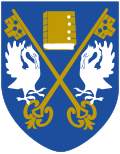Old Brightonians F.C.
 |
|
| Motto | ΤΟ Δ’ΕΥ ΝΙΚΑΤΩ (Let right prevail) |
|---|---|
| Established | 1845 |
| Type |
Independent day and boarding school public school |
| Headmaster | Richard Cairns |
| Chaplain | Father Robert Easton |
| Chairman of the Governors | Professor Lord Robert Skidelsky |
| Founder | William Aldwin Soames (1787-1871) |
| Location |
Eastern Road Brighton East Sussex BN2 0AL England Coordinates: 50°49′11″N 0°07′11″W / 50.8196°N 0.1197°W |
| Local authority | Brighton and Hove |
| DfE number | 846/6008 |
| DfE URN | 114614 Tables |
| Staff | 150 |
| Students | 910 (ages 11 - 18) |
| Gender | Coeducational |
| Ages | 3–18 |
| Houses | 13 |
| Colours | Red and blue |
| Publication | Brighton College Newsletter |
| Former pupils | Old Brightonians |
| Website | www |
Independent day and boarding school
Brighton College is a boarding and day school for boys and girls aged 11–18 in Brighton, England. Brighton College Preparatory School, for children aged 8 to 13, is located immediately next to the College itself and shares many of its facilities. The Pre-Prep School, for children ages 3 to 8, has its own site close by.
Brighton College was named UK School of the Year 2013 at the Independent Schools Awards on 14 November 2013. The judges cited "the college's extraordinary academic success (the only school in England to have seen exam results improve every single year for seven years), clear strategic vision, strong social mission and dynamic expansion". It was also named 'England's Independent School of the Year 2011-2012' by The Sunday Times. The school's Head Master, Richard Cairns, was awarded the title England's Public School Headmaster of the Year 2012 by Tatler magazine.
In 2011, Brighton College opened Brighton College Abu Dhabi, the first in a planned chain of international schools. Charging up to £12,880 per term for boarders in 2015/16 makes it the most expensive HMC boarding school in the UK.
Founded in 1845 by William Aldwin Soames, Brighton College was the first Victorian public school to be founded in Sussex.
There are 13 houses at Brighton College. The houses are split by gender, although staff of both sexes can be attached to any house. Houses contain between 48 and 85 pupils and are governed by a house master and a team of tutors with boarding houses also having a matron and house keeping staff. The house master is free to appoint members of the Upper Sixth to act as house prefects to look after and supervise younger members of the house. The house master also appoints one member of the Upper Sixth to act as head of house, a role which involves the same duties as a house prefect as well as representing their house at house events and competitions.
...
Wikipedia
